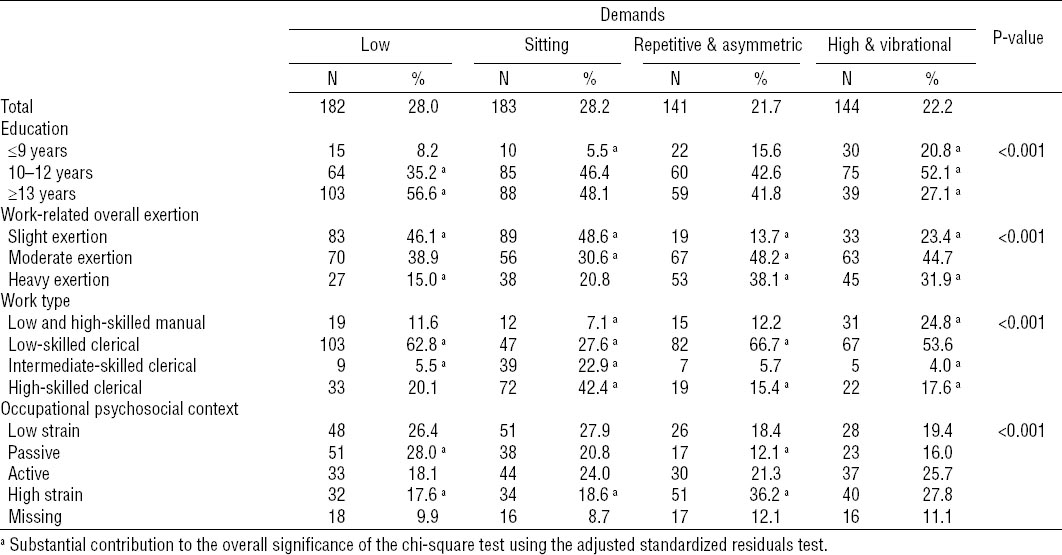Musculoskeletal conditions are the most common cause of severe long-term pain and physical incapacity, representing 17% of the total years lived with disability among the young adult population worldwide (1, 2). Even though these diseases are multifactorial, work-related factors account for 30–40% of musculoskeletal complaints among active workers (3). In turn, musculoskeletal pain has been pointed as the main cause of work disability, and it is the most frequent reason for long-term sick leave and early retirement (4, 5).
Occupational exposures such as external loads, organizational factors and psychosocial work environment are strong determinants of musculoskeletal pain (6). Among those, physical factors such as heavy loads, bending or twisting, vibrations and awkward postures are the strongest predictors of multisite musculoskeletal pain, probably due to the direct mechanical tissue overload induced on joints (7–9).
Most research on the biomechanical etiology of work-related musculoskeletal conditions has focused on adults of heterogeneous age ranges (10). In such context, the well-documented healthy worker bias is expected to arise since workers with musculoskeletal complaints are more likely to have retired early or to be moving towards less demanding mechanical tasks. In addition, changes throughout life in the individual’s work-related biomechanical demands lead to increasing misclassification of cumulative exposure with advancing stages of professional life.
Recent studies among newly-employed workers have shown that even short-term exposures to mechanical loads contribute significantly to the etiology of musculoskeletal pain, which suggests that investigating occupational health since the beginning of professional life may guide the timing of preventive strategies (11–14). However, research in early stages of employment remains fairly scarce, as well as restricted to a limited number of anatomical regions and specific occupational groups.
Work activities are commonly characterized by a narrow spectrum of co-occurring biomechanical demands (15) that cluster within workers and create different patterns of physical exposures in the occupational setting (16). Most previous evidence has emerged from independent analysis of isolated mechanical tasks, disregarding the potential synergistic effects of multiple combinations of distinct biomechanical factors in determining regional musculoskeletal pain (17). Such synergistic effect on low-back pain was indeed suggested in a 2011 study of students with traineeship-related occupations (18). Currently, still little is known about the association between the effective beginning of professional life – with the diversity of exposures as they occur in the current labor market – and the occurrence of pain in the musculoskeletal system as a whole.
Therefore, using data collected in a population-based sample of 21-year-old adults, we aimed to: (i) describe patterns of occupational biomechanical demands; and (ii) assess whether exposure to different patterns of work-related biomechanical demands have an effect on the presence and intensity of regional musculoskeletal pain in the beginning of professional life.
Study population and methods
Participants
In this study, we use cross-sectional data collected in 2011–2013 from young adults as part of the Epidemiological Health Investigation of Teenagers in Porto (EPITeen). The EPITeen study was designed as a prospective cohort first assembled during the 2003/2004 school year, when we approached all public and private schools in Porto (Portugal) providing teaching to adolescents born in 1990. In the first wave, we identified 2787 eligible adolescents, of whom 2159 agreed to participate (77.5% baseline participation). In 2007/2008 (second wave), the initially recruited sample was re-evaluated and 783 students born in the same year but who moved to Porto after 2003/2004 were additionally recruited to the cohort. Sampling procedures and detailed methods have already been described (19).
During 2011–2013, 1761 young (21 years old) adults (of the 2942 eligible for follow-up) attended the third evaluation wave on which the present paper is exclusively based. We excluded 23 subjects due to neurodevelopmental or other illness (eg, autism spectrum disorders) and five due to missing data on work status. A final sample of 1733 individuals was included in the present analysis, considering both 1083 participants who were non-workers (more than 80% full-time students) and 650 workers (appendix 1: http://www.sjweh.fi/data_repository.php).
Participants included (N=1733) were similar to those lost to follow-up regarding sex, body mass index and smoking behavior at 13 years of age. However, subjects attending follow-up were more sedentary (mostly sitting during leisure time: 31.1% versus 24.5%, P=0.012) and had higher parental education (mean schooling years: 11.4 versus 9.2, P<0.001).
The Ethics Committee of University Hospital of São João (Porto) approved the study protocol, which was carried out in accordance with the principles of the Declaration of Helsinki. Written informed consent was obtained from all participants.
Data collection
Occupational biomechanical characteristics
Exposures to ten different work-related biomechanical demands (sitting posture, computer use, whole body vibrations, handling vibration tools, precision demands, repetitive tasks, overhead work, kneeling work, bending or rotation movements, and manual materials handling) were assessed among all participants who had worked for at least one month in the previous year.
The average fractions of a regular working day that were spent in sitting position, using the computer, exposed to whole body vibrations, and handling vibration tools were measured through a visual analogue scale, ranging from 0–100%. The absolute number of weekly hours of exposure to those mechanical demands was computed by multiplying the percentage of time performing each task by the daily number of working hours (full-time=8 hours, part-time=4 hours, less than a part-time job=2 hours), assuming a constant average of five working days per week. Participants were then grouped as above or below the sample median of weekly hours exposed to each biomechanical demand.
Workers were also asked to quantify the frequency of precision demands, repetitive tasks, overhead work, kneeling work, bending or rotation movements, and manual materials handling using Likert scales ranging from 0=never to 5=every day. Participants were classified as exposed to each biomechanical factor if it occurred at least one day per week. In particular, “bending or rotation movements” and “manual materials handling” were assessed using two items each. Since both items were intended to measure the same underlying construct, three categories of exposure to these biomechanical tasks were defined (both absent; one present; and both present) for the purpose of latent class analysis.
The remaining time of the working day not accounted for by any of the ten abovementioned biomechanical demands was classified as unexposed time.
Regional musculoskeletal pain
Regional musculoskeletal pain was assessed using the Nordic Musculoskeletal Questionnaire (20), which has been validated in the Portuguese population (21). This questionnaire evaluates the presence of musculoskeletal pain during the preceding 12 months in nine different anatomical regions: neck, shoulders, elbows, wrists/hands, upper back, lower back, hips/thighs/buttocks, knees and ankles/feet. In order to minimize potential misclassification and considering the expected effect of work-related demands on adjacent musculoskeletal regions, we aggregated anatomical sites into four major groups: neck and shoulders, upper limb (elbows and wrists/hands), upper and lower back, and lower limb (hips/thighs/buttocks, knees and ankles/feet). Moderate-to-severe pain was considered present if the reported intensity was >40 millimeters in the visual analogue scale (22). If more than one painful site was simultaneously present within aggregated regions, we chose the highest pain intensity. Additionally, the total number of painful anatomical sites was computed and varied between 0–9.
Covariates
Based on published evidence, anthropometrics and lifestyles (23), socioeconomic context (24), and psychosocial characteristics of the occupation (25) were considered a priori as confounders of the relation between occupational biomechanical demands and regional musculoskeletal pain.
Anthropometric parameters were obtained while subjects stood barefoot in light indoor clothing. Body mass index was then calculated as the weight (kilograms) divided by the square of height (meters) and individuals were grouped according to the World Health Organization classification: underweight (<18.5 kg/m2), normal weight (18.5–24.9 kg/m2), overweight (25.0–29.9 kg/m2) or obese (≥30 kg/m2). Duration and intensity of leisure time physical activity were also collected with participants classifying their activity as: sitting most of the time, standing and/or walking (but not running) or very active. Frequency of smoking was gathered and young adults were grouped as never smokers, ex-smokers or current smokers. Educational level has been shown to be the most accurate indicator to assess the effect of socioeconomic position on health outcomes in the Portuguese population (26, 27). Accordingly, formal education was recorded as completed years of schooling and subjects were grouped according to the International Standard Classification of Education as ≤9, 10–12, or ≥13 years of education. Among workers, occupational psychosocial context was assessed using the self-administered Job Content Questionnaire (28) and participants’ jobs were categorized into one of the four quadrants of Karasek’s Job Strain Model: (i) low strain, high decision latitude and low psychological demands; (ii) passive, low decision latitude and low psychological demands; (iii) active, high decision latitude and high psychological demands; and (iv) high strain, low decision latitude and high psychological demands (29).
Additionally, overall exertion of work-related tasks was measured using the Borg scale (range: 6–20) (30) and individuals were categorized as having slight exertion (smallest scores), moderate exertion (13–14 points) or heavy exertion occupations (highest scores). Occupations were grouped according to the International Standard Classification of Occupations-88 (31) as low and high-skilled manual (armed forces, skilled agricultural and fishery workers, craft and related trade workers, plant and machine operators and assemblers and elementary occupations), low-skilled clerical (service workers and shop/market sales workers), intermediate-skilled clerical (clerks) and high-skilled clerical (legislators, senior officials, managers, professionals, technicians and associated professionals).
Statistical analysis
Patterns of occupational biomechanical demands
Latent class analysis was used to uncover distinct groups of homogenous individuals from our sample in order to create patterns of biomechanical demands. This approach considers that the performance of an individual in a set of items is explained by a categorical latent (unmeasured) variable with K classes (32). Interpretation of the model is usually based on item profiles in each category, obtained from the probabilities of each subject endorsing each response item, conditional on class membership.
In this study, the number of latent classes (also referred to as patterns) was selected considering the models with the smallest Bayesian information criterion (BIC) and according to the Lo-Mendell-Rubin likelihood ratio test that quantifies the likelihood that the data can be described by a model with one-less class. Starting from one single class and increasing one class at each step, the best solution was identified when the increase in the number of classes did not lead to a further decrease in the BIC. Based on previous knowledge regarding the data necessary to accurately measure the biomechanical exposure in the workplace (30, 33, 34), the ten occupational biomechanical factors described-above (items) were used in the latent class analysis fitted using MPlus (V.5.2; Muthen & Muthen, Los Angeles, California, USA). Although the majority of participants had complete information for all items, 16.6% had missing values in one single item and 4.5% in two or more. As by default MPlus uses the full information maximum likelihood to estimate the latent class analysis model, individuals with missing values were not excluded, ie, they were classified into one of the classes using information from the remaining items.
To assess the criterion validity of the final class solution, we tested the relation between patterns of occupational biomechanical demands and education, work-related overall exertion, work type and occupational psychosocial context, ie, variables expected to vary between classes but not used to determine the class solution itself. The statistical significance of differences between classes was estimated using chi-square test, and post-hoc analyses were computed to determine which classes made a substantial contribution to the overall significance of the chi-square test (adjusted standardized residuals with absolute values >1.96 were considered relevant).
Occupational biomechanical patterns and musculoskeletal pain
Sample characteristics are presented as counts and proportions for all categorical variables. In order to quantify the associations between patterns of occupational biomechanical demands and regional musculoskeletal pain (presence and intensity), logistic regressions were performed using two different conceptual approaches: (i) demands versus non-workers: to assess the potential effect of each pattern of work-related demands versus no demands, we considered the whole sample and compared each of the four groups of workers with non-workers (the latter were 80% students and were considered unexposed to work-related biomechanical demands); (ii) high versus low work demands: to assess the potential effect of different physically-demanding patterns versus low demands, we considered only workers and compared each of the three groups with physically-demanding patterns with the low-demands group (the latter less exposed to work-related biomechanical demands). Using the same conceptual approaches, multinomial logistic regressions were also performed having multisite musculoskeletal pain as outcome.
Crude and adjusted odds ratios (OR and ORadj) with 95% confidence intervals (95% CI) were computed. For the demands versus non-workers approach, estimates were adjusted for sex, body mass index, physical activity, smoking and education. In the high versus low work demands approach, in which confounding by occupational psychosocial context may occur, associations were additionally adjusted for job strain (Karasek’s Job Strain Model).
Statistical analyses other than latent class analysis were performed using Stata® version 11.2 for Windows (Stata Corp LP, College Station, Texas, USA).
Results
Table 1 summarizes the characteristics of EPITeen participants. Most subjects were female, had healthy weight, spent most of the time standing or walking in their leisure activities, were non-smokers, and had ≥13 schooling years. Among workers (37.5% of the whole sample), 51.4% were low-skilled clerical, 69.1% had been working ≤1 year, and 49.0% had a full-time job. Near a quarter of workers perceived their occupation as highly strained.
Table 1
Anthropometrics, lifestyles and socioeconomic characteristics of participants of the EPITeen cohort according to work status. Sample size is not constant due to missing data in body mass index (N=19), physical activity (N=2), smoking (N=2), education (N=1), work-related overall exertion (N=7), work type (N=68), work duration (N=65) and working time (N=41).
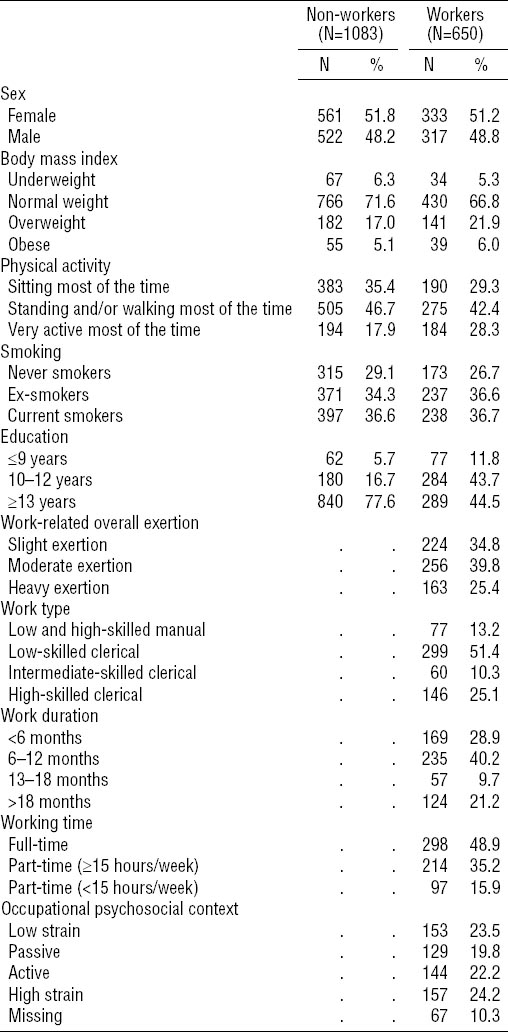
Patterns of occupational biomechanical demands
As for occupational biomechanical patterns, BIC reached its optimum value at four or five classes, but the Lo-Mendell-Rubin likelihood ratio test of model fit confirmed that four classes were enough to describe the observed data (P=0.291). The average latent class probabilities (most likely latent class membership) showed high discrimination between classes, varying between 0.86–0.94. The final class solution was characterized by the following item profiles, which we named as follows: “low demands” assigned low probability to all items (eg, security guards and staff, receptionists, stewardesses and sales promoters); “sitting demands” was mainly characterized by sitting posture and computer use (>95%; eg, administrative staff, call-center operators, teachers and lawyers); “repetitive and asymmetric demands” presented high probability of repetitive tasks, bending or rotation movements and manual materials handling and intermediate probability (near 50%) of including overhead and kneeling work (eg, shop staff, market sales staff, and hairdressers); and “high and vibrational demands” allocated the highest probability to all items (except sitting and computer use) with a maximum probability of exposure to whole-body vibrations and vibration tools handling (eg, mechanics, electricians, warehouse staff and farmers) (table 2 and figure 1).
Table 2
Marginal percentage of subjects with each occupational biomechanical demand in each assigned latent class (pattern) to predict class membership among 21-year-old young adults (N=650).
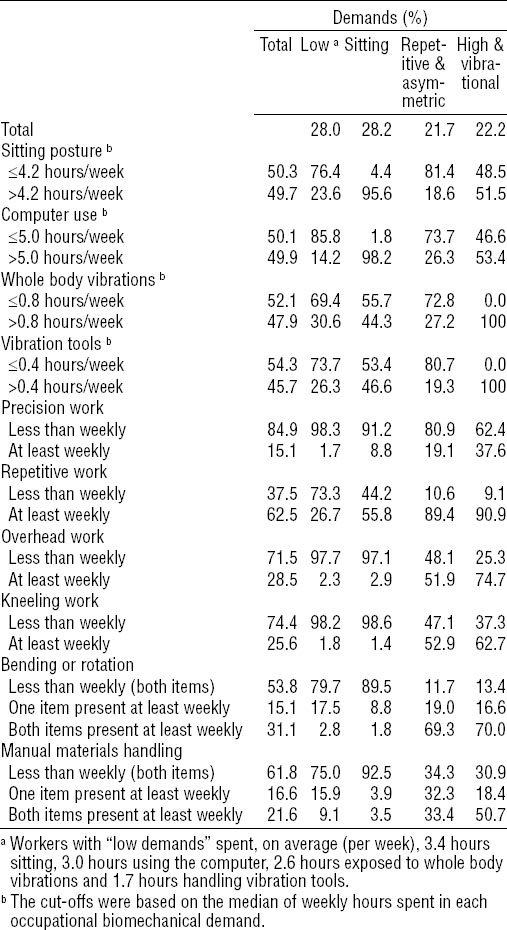
Figure 1
Marginal percentage of subjects with each occupational biomechanical demand in each assigned latent class (pattern) to predict class membership in 21-year-old young adults.
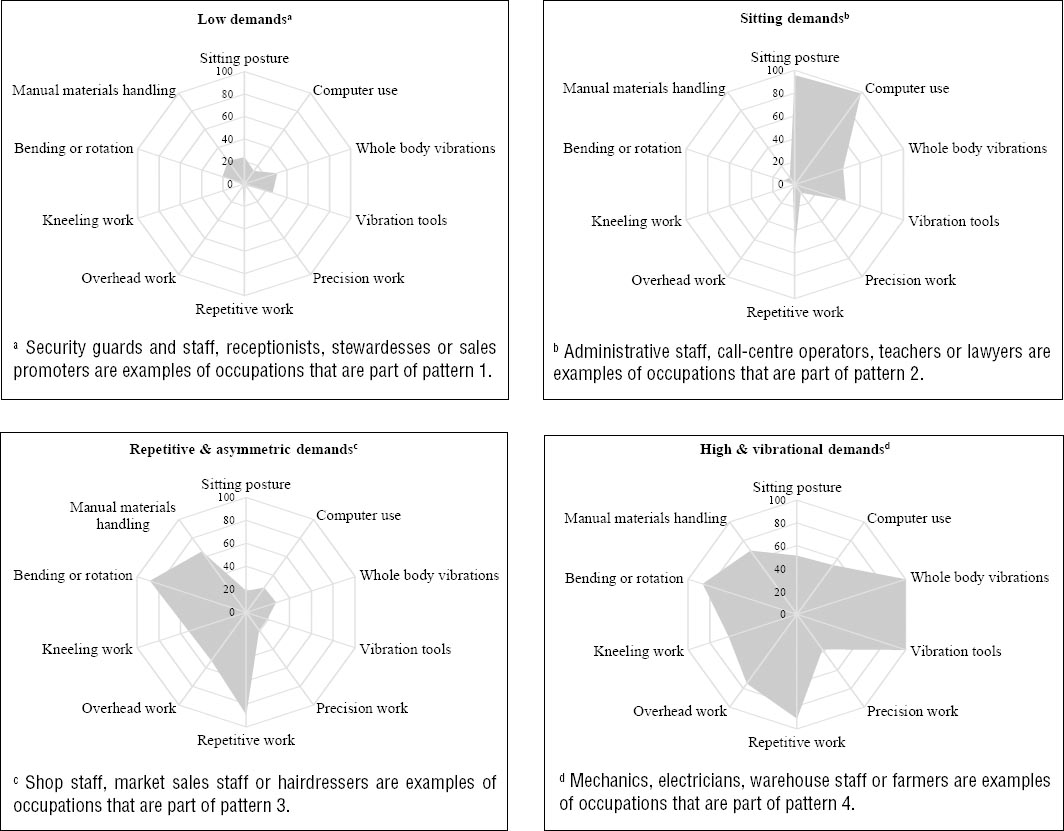
The criterion validity of the model is presented in table 3. High formal education was more frequent among workers with low-demands occupations (56.6%) and less frequent among high- and vibrational-demands occupations (27.1%, P<0.001). While workers with low- (46.1%) or sitting- (48.6%) demands occupations considered more frequently their work-related overall exertion as slight, workers with repetitive- and asymmetric- (13.7%) or high- and vibrational- (23.4%) demands occupations were those less frequently reporting their job exertion as slight (P<0.001). Sitting demands (7.1%) were less frequently observed in manual jobs, whereas manual workers more frequently reported high- and vibrational-demands occupations (24.8%, P<0.001). Occupations with low (17.6%) or sitting (18.6%) demands were more frequently reported as highly strained while repetitive and asymmetric (36.2%) and high- and vibrational- (27.8%) demands occupations were less frequently considered to be highly strained (P<0.001).
Patterns of occupational biomechanical demands and regional musculoskeletal pain
Demands versus non-workers (workers versus non-workers)
Workers whose occupation was characterized by repetitive and asymmetric and high and vibrational demands were significantly more likely to report neck/shoulder pain when compared to non-workers [respectively, ORadj 1.54 (95% CI 1.06–2.22) and 1.56 (95% CI 1.08–2.27)]. Sitting and high and vibrational demands were significantly associated with the report of upper-/lower-back pain when compared to non-workers: ORadj 1.70 (95% CI 1.20–2.42) and 1.95 (95% CI 1.30–2.92), respectively. Sitting, repetitive and asymmetric, and high and vibrational demands were significantly associated with moderate-to-severe upper-/lower-back pain with ORadj ranging between 1.56 (95% CI 1.05–2.33) and 1.62 (95% CI 1.14–2.31) (tables 4a and 4b). As observed in figure 2, workers whose occupation was characterized by high and vibrational demands were more likely than non-workers to report pain in at least one anatomical site, and this effect was stronger as we increased the threshold of number of painful anatomical regions: ORadj1 2.21 (95% CI 1.08–4.50), ORadj2 2.75 (95% CI 1.34–5.62), and ORadj≥3 2.81 (95% CI 1.43–5.52).
Table 4a
Associations between patterns of occupational biomechanical demands and presence of regional musculoskeletal pain among 21-year-old young adults. [OR=odds ratio; 95% CI=95% confidence interval].
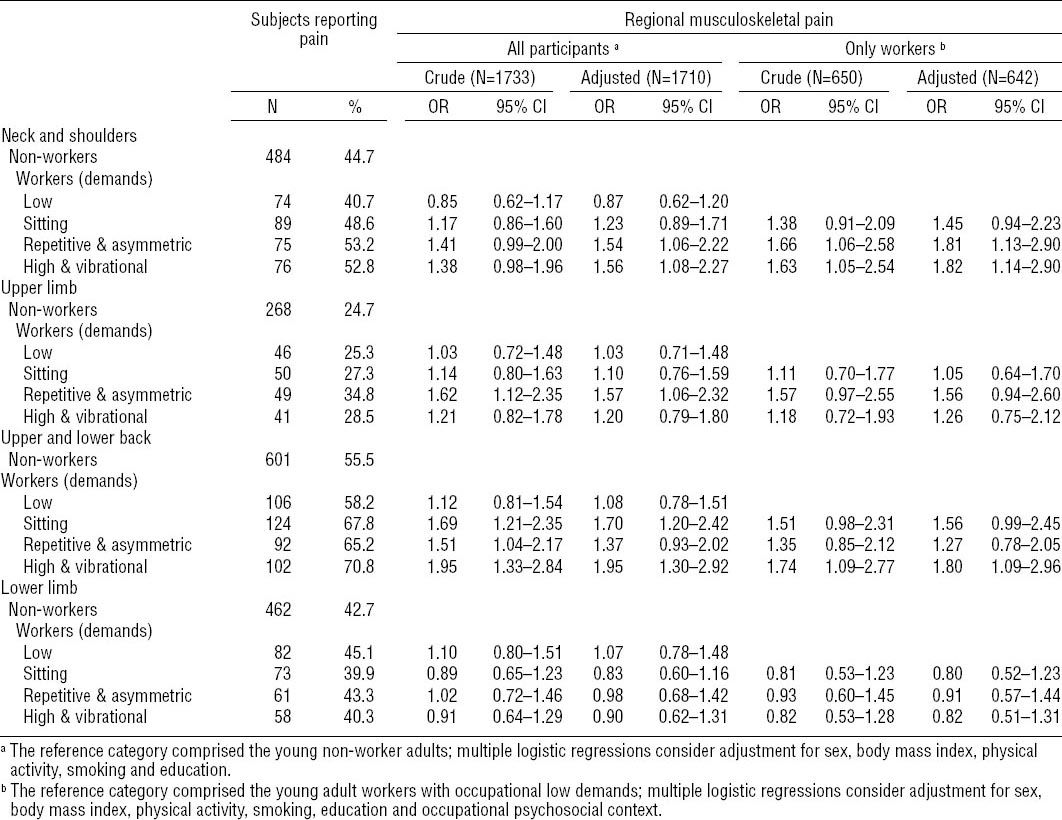
Table 4b
Associations between patterns of occupational biomechanical demands and moderate to severe regional musculoskeletal pain in 21-year-old young adults. [VAS=visual analogue scale; OR=odds ratio; 95% CI=95% confidence interval].
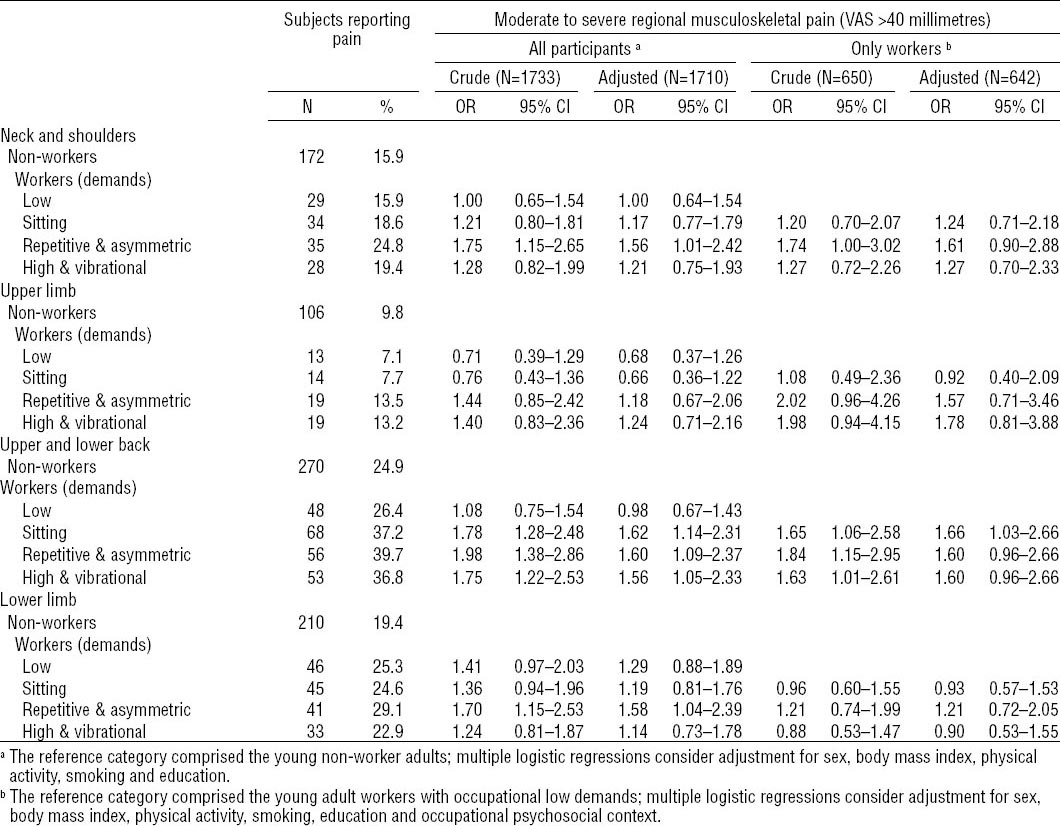
Figure 2
Adjusted associations between patterns of occupational biomechanical demands and multisite musculoskeletal pain among 21-year-old young adults. a The comparison group comprised the young adult non-workers without regional musculoskeletal pain (adjusted for sex, body mass index, physical activity, smoking and education). b The comparison group comprised the young adult workers in the occupational pattern of low demands without regional musculoskeletal pain (adjusted for sex, body mass index, physical activity, smoking, education and occupational psychosocial context).
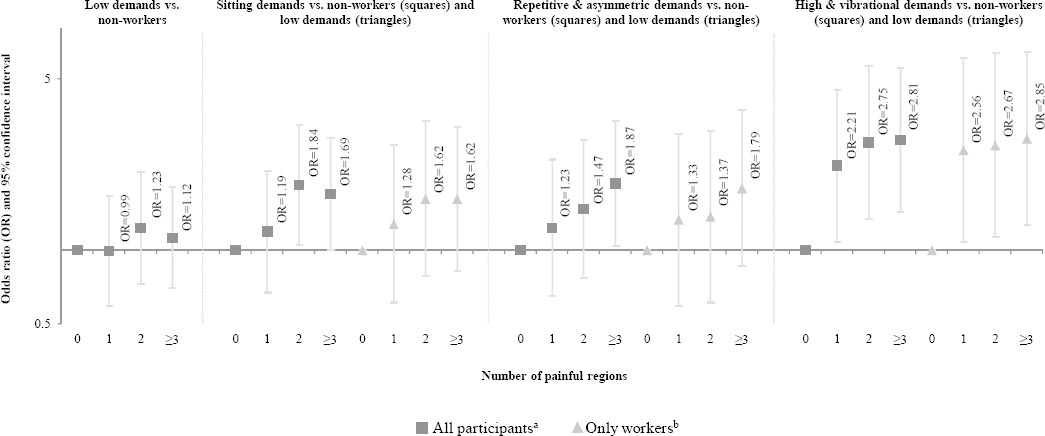
High versus low work demands (workers with physically-demanding patterns versus low demands)
As presented in tables 4a and 4b, workers exposed to occupations with repetitive and asymmetric and high and vibrational demands were more likely to report neck/shoulder pain than those with low demands [ORadj 1.81 (95% CI 1.13–2.90) and 1.82 (95% CI 1.14–2.90), respectively]. High and vibrational demands were significantly associated to the presence of upper-/lower-back pain when compared to low demands (ORadj 1.80, 95% CI 1.09-2.96). Workers with sitting demands were more likely to report any or moderate-to-severe upper-/lower-back pain than those with low demands: ORadj 1.56 (95% CI 0.99–2.45) and 1.66 (95% CI 1.03–2.66) respectively. High and vibrational demands were associated with pain in at least one anatomical site when compared to low demands, and the magnitude of associations was stronger as the threshold of number of painful anatomical regions increased: ORadj1 2.56 (95% CI 1.08–6.08), ORadj2 2.67 (95% CI 1.13–6.34), ORadj≥3 2.85 (95% CI 1.26–6.42) (figure 2).
Discussion
In this community-based study of young adults, we identified four clearly distinct patterns of exposure to occupational biomechanical demands. Even in the early stages of employment, repetitive and asymmetric and high and vibrational demands were associated with the presence of neck/shoulder pain. Patterns of increased biomechanical demands, especially sitting and high and vibrational demands, showed higher risk of any or severe upper-/lower-back pain. Moreover, the odds of multisite pain increased with growing biomechanical workplace demands.
In the beginning of professional life, work-related demands may affect health outcomes not only through a direct biomechanical effect on body structures, but also because labor market entry is a stressor in itself (18). Our comparison between subjects with each exposure pattern and non-workers intended to measure the cumulative effect of being employed plus having a certain pattern of demands versus being unexposed to employment-related mechanical demands (ie, background propensity for pain in the source population). The comparison with the low demands group (exposed to employment but less exposed to mechanical demands) aimed to isolate the effects of the demands themselves. Despite this conceptual difference, associations remained very similar regardless of reference group, suggesting that meaningful differences are attributable to demanding biomechanical exposures rather than employment status by itself.
Even short-term exposures to repetitive and asymmetric or high and vibrational demands were associated with neck/shoulder pain in this investigation. Previous studies in samples of newly-employed workers have shown that repetitiveness, sustained trapezius muscle activity, and high force demands are significant predictors of neck and shoulder pain (11, 35, 36). Additionally, high and vibrational demands were also associated with upper-/lower-back pain. Occupational mechanical load – lifting and pushing, pulling heavy weights or overhead tasks – has also been pointed out as playing a major role in the onset of low-back pain (14), even among adolescents with regular or irregular exposures to physically-demanding jobs (18).
In addition to the well-documented fact that work-related musculoskeletal pain can be caused by fibrotic and structural changes from tissue injury and consequent micro-trauma (37–39), work-related physically-demanding tasks have also been shown to be related to the occurrence of monotonic muscle contractions that may cause pain (40, 41). This is expected to be even more pronounced among young workers since their willingness to comply with all the work-related tasks in a short period of time may lead to involuntary muscle contraction in an uncoordinated way without relaxing pauses, which may ultimately result in regional pain. (42). Concordantly, our findings supported that short-term exposures to physically-demanding patterns of occupational biomechanical demands may have been sufficient to cause meaningful permanent or transient disturbance to neck/shoulder and upper/lower back structures.
Another site-specific harmful effect was observed regarding the pattern of sitting demands and the presence of any or severe upper-/lower-back pain. Due to the low activation of lumbar muscles while sitting, load is absorbed by viscoelastic structures and transmitted directly to the spine, causing muscle contractions and/or structural damage and consequent severe back pain (43). Nevertheless, controversy still exists regarding the impact of occupational sitting posture on back pain (17), since extremely high doses of exposure are supposedly needed to affect spinal structures (44). The detection of this effect in such early stages of employment may be the result of our empirical characterization of demands that captured a more realistic pattern in which computer use and sitting posture co-occur. We believe that this better represents overall sitting-related demands to the detriment of traditional measurements of time spent sitting as a single and independent exposure. An additional explanation is the potential independent effect of workplace rules and obligations, which are frequently interpreted as rigid and inflexible in the beginning of professional life and may lead to excessive periods of time spent uninterruptedly sitting (45).
Another relevant result of our study was that the risk of multisite pain increased with growing occupational biomechanical demands. Particularly, for high and vibrational demands occupations, associations were stronger as we increased the threshold of the number of painful anatomical regions, which is in agreement with previous evidence in long-term workers (46, 47). These findings suggest that, from the earliest stages of employment, high demands may rapidly produce musculoskeletal pain in more than one body region (particularly in the neck/shoulder and upper-/lower-back areas, ie, the regions most frequently reported as painful). Adding to that, in the specific case of multisite pain, it is likely that the overall psychosocial context of the occupation contributes to the reported symptoms in addition to the potential effects of biomechanical exposures. However, we do not believe that the former was a major confounder here since our estimates were adjusted for job strain.
With scarce exceptions, we did not observe significant associations between patterns of biomechanical demands and musculoskeletal pain in the upper or lower limbs. The literature has been inconsistent in detecting an influence of work-related physical demands on limb pain in early stages of professional life (12, 13, 48) and, when associations have been found, they are commonly much weaker than those estimated for shoulders or back regions. In such early stages of professional life, it seems that the duration of exposure to adverse biomechanical demands is too short to produce tissue damage above the biological threshold for musculoskeletal pain.
To the best of our knowledge, this study was a pioneer in using a population-based approach to estimate the associations between empirically-defined patterns of occupational biomechanical demands and musculoskeletal pain among young adults in the beginning of professional life. Our population-based approach adds a scenario of a wide range of real-world occupations performed in a decade where the typology of the early stages of employment has changed dramatically (49). This updates previous knowledge and supports the generalization of our results to other young adult populations.
Additionally, this study aimed to identify patterns using an extensive characterization of interrelated biomechanical demands that may function as markers of early development of pain and, consequently, may be the target for intervention since the beginning of the professional life. Our latent class approach provided an innovative, pragmatic and likely more valid characterization of the exposure since it considers the co-occurrence of different but closely linked work-related biomechanical tasks (8).
Furthermore, we evaluated not only the presence of pain, but also severity and its co-occurrence in different anatomical regions. We believe that considering different pain outcomes (anatomical diversity, intensity and number of painful regions) allowed us not only to study the effect of occupational biomechanical demands across a wide spectrum of pain severity stages, but also to validate our findings regarding the anatomical plausibility of exposure-outcome relations, since the strength and statistical significance of associations were consistent across different outcomes.
Nevertheless, some methodological concerns should be addressed. Individuals comprising the non-workers reference group were not totally “unexposed” to biomechanical demands, but we did not collect detailed demands in this group. Nevertheless, a rapid assessment of physical exertion showed that nearly three quarters of non-workers reported to spend most of the day sitting (data not shown). In line with this, low-demand workers were exposed to all types of biomechanical demands, but all of them with low duration and frequency. It is likely that the remaining time (not accounted for by any of the biomechanical demands considered) was spent standing or walking without any other simultaneous physical demand, which in our perspective qualifies as unexposed time. This assumption was supported by the jobs included (vigilantes and security staff, receptionists, stewardesses and promoters), but we did not collect information on the duration/frequency of periods with no (or nearly null) biomechanical demands, ie we characterized exposure to a set of frequent and work-related demanding exposures and assumed that the remaining working time was unexposed.
As workers were at the beginning of their professional lives, exposure to occupational biomechanical demands was assumed to be reasonably short. This assumption was corroborated by our observation that the majority of participants had been working for ≤12 months (nearly 70%) and the maximum duration of work was 72 months.
Due to its cross-sectional design, conclusions on the temporality can be argued but not proven and prudence is needed when inferring causality from the associations found in this investigation. Firstly, although EPITeen participants have been followed since early adolescence, data on musculoskeletal pain were not collected before 21 years of age. Therefore, we were not able to distinguish between acute and chronic complaints. Our methodological option of not assessing pain history cross-sectionally was related to the high likelihood of differential recall of past pain according to current complaints (50). As musculoskeletal complaints often begin in early stages of life (51), psychosocial and lifestyle pathways other than occupational exposures are plausible to have caused pain onset (52). Within this framework, we cannot exclude that our findings were the result of alternative pathways of musculoskeletal pain development throughout the life course, where occupational biomechanical demands may only partly explain musculoskeletal complaints. To deal with this, we adjusted estimates for other documented psychosocial causes of pain, which in our view have minimized potential confounding. Secondly, the healthy worker effect, through which musculoskeletal symptoms may themselves determine the choice or persistence of a specific less demanding occupation, cannot be excluded. However, it seems unlikely that pain has led a substantial proportion of individuals to radically change their exposure status before the age of 21 years. In fact, we believe it to be more likely that biomechanical factors have preceded pain rather than earlier pain has determined the selection of a specific less-demanding occupation. Thirdly, as exposures and outcomes were collected retrospectively, individuals with pain symptoms may have recalled occupational exposures as more frequent and/or demanding than those who did not present such complaints. Nevertheless, in this study, data have been collected as part of an extensive protocol that assessed a wide spectrum of health-related information and subjects were not expected to be particularly aware of the main hypothesis addressed in this particular study.
Regional musculoskeletal complaints were assessed using the widely accepted standardized recall period of 12 months. Since our sample included only young adult workers, a relevant percentage of those had been employed for <1 year: 28.9% for <6 months, 21.2% for 6–9 months and 5.0% for 10–11 months. Therefore, recall times for exposure and outcome did not completely overlap in this fraction of the sample, ie, musculoskeletal pain might have referred to an unexposed period with regard to occupational biomechanical demands. Sensitivity analyses were performed by restricting estimates to individuals that had been working for ≥1 year and similar conclusions were supported by the results (appendix 2, http://www.sjweh.fi/data_repository.php), despite the reduced statistical power to identify significant differences between groups.
Finally, the extent to which any cohort represents the source population throughout follow-up is likely to decrease over time because of differential losses to follow-up. Participants reassessed at 21 years were reasonably similar to those lost to follow-up in a wide number of characteristics measured in the baseline evaluation, but attrition was significantly higher among individuals with low social position. Despite that, we do not believe that the underrepresentation of young adults with social disadvantage has substantially biased our estimates since we found no associations between parental education and musculoskeletal pain.
In conclusion, we found four clearly distinct patterns of biomechanical demands in the general population of young workers. Even in early stages of employment, physically-demanding patterns at the workplace were associated with the presence of neck/shoulder pain and with the presence and severity of upper-/lower-back pain. Our study emphasizes that even short-term biomechanical exposures at the workplace may be involved in the etiology of musculoskeletal complaints.


